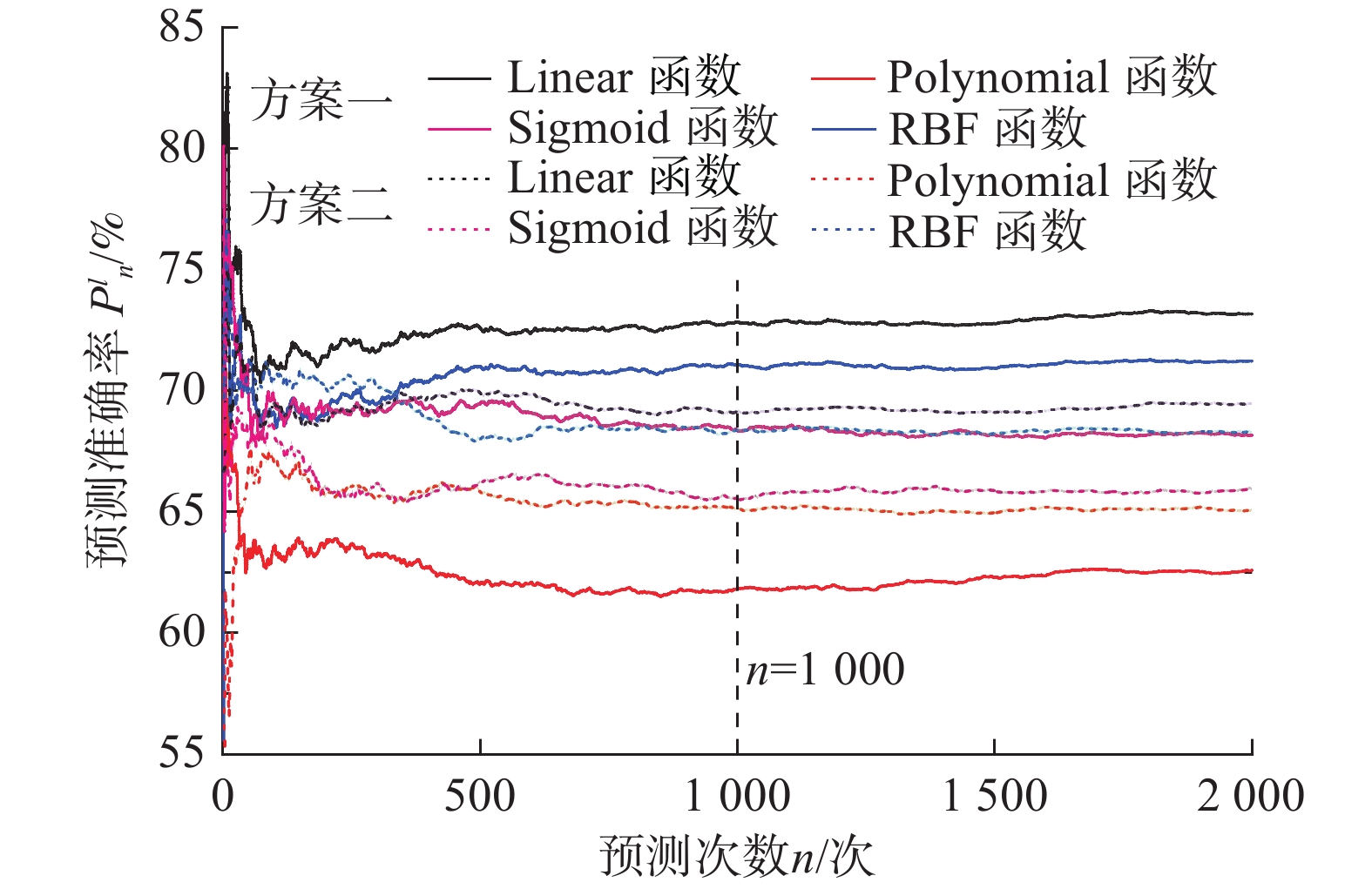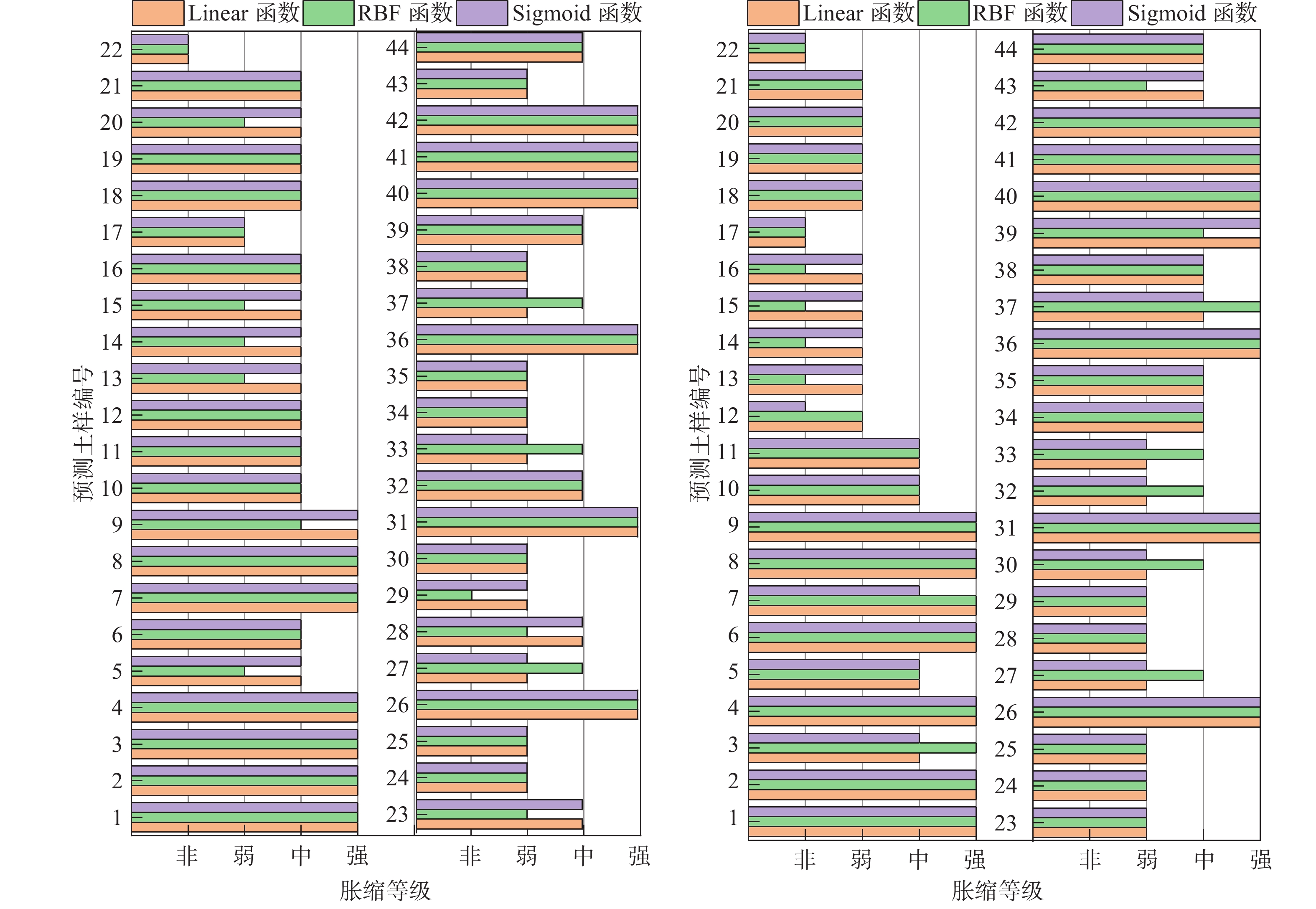Predicting of swelling-shrinking level of expansive soil using support vector regression
-
摘要:
膨胀土的胀缩等级判定对膨胀土地区工程建设具有重要的意义。为此,本文提出了一种基于支持向量回归机(SVR)模型的膨胀土胀缩等级预测方法。基于肯尼亚“蒙内铁路”沿线膨胀土的土工试验数据,以土体自由膨胀率作为预测目标,构建了包含两种不同预测指标体系的膨胀土胀缩等级预测模型。模型I以液限、塑限、塑性指数、3种不同粒径的颗粒含量(< 0.075、0.075~0.25、0.25~0.5)、土的类型为输入参数,模型II以液限、塑限、塑性指数、粒径< 0.075的颗粒含量、土的类型为预测参数。两个模型在预测时采用Linear、Polynomial、RBF和Sigmoid核函数进行训练。结果表明:(1)当预测采样次数达到1000次时,训练模型均趋于稳定;(2)整体而言,模型I的预测精度要优于模型II,模型I中采用RBF核函数建立的模型给出了最高准确率86.6%,其次为Linear核函数(准确率82.9%)和Sigmoid和函数(准确率75.1%)。模型II中采用RBF核函数建立的模型给出了最高准确率77.4%,其次为Linear核函数(准确率74.3%)和Sigmoid和函数(准确率72.9%);(3)采用Linear函数、Sigmoid函数和RBF函数作为核函数模型对44组未知胀缩等级的土样预测时,模型I中三者预测结果相同的数量占比为73%,其余组土样的预测胀缩等级相同或相邻,不存在“越级”现象,模型II中三者预测结果相同的数量占比为68%,不存在“越级”现象。最后,通过与模糊层次分析法评价结果对比,进一步证明了本文研究结果可为肯尼亚等类似地区工程建设中膨胀土的胀缩等级预测和处理提供依据。
Abstract:Level scaling of expansive soil is of significant importance in practical engineering. In this study, a support vector regression (SVR)-based predicting model of expansive soil level was proposed. Using the laboratory test dataset of expansive soil in Kenya, two training models with different predictors were built. Seven parameters, including liquid limit, plastic limit, plastic index, particle percentage of three different particle sizes (< 0.075、0.075~0.25、0.25~0.5), and soil type, were used in model I, while five parameters, including liquid limit, plastic limit, plastic index, percentage of particles with size < 0.075 and soil type, were used in model II. For each model, four kernels namely, Linear, Polynomial, RBF and Sigmoid, were used. The result had shown that all training models become stable when the sampling number reached 1000.The results show that with the increase of the number of randomly selected training samples, when the number of predictions reaches 1000, the prediction accuracy obtained by the SVR models with 4 different kernel functions basically stabilizes. The prediction effect is better when the RBF function and Linear function are used, followed by the Sigmoid kernel function. The prediction accuracy of the above three is more than 70% in scheme one, and prediction accuracy of the above three is more than 70% in scheme two. When Linear function, Sigmoid function, and RBF function are used as kernel function models to predict 44 groups of unknown expansive scale soil samples, the number of identical prediction results accounts for 73% in scheme one. The prediction scale of the remaining sets of soil samples is the same or adjacent, there is no "crossing" phenomenon. The number of identical prediction results accounts for 73% in scheme two, and there is no "crossing" phenomenon. The results of the study can provide a basis for the prediction and treatment of the scale of the expansion soil in the construction of Kenya and other regions.
-
Key words:
- expansive soil /
- expansive scale /
- SVR /
- free swelling rate /
- prediction accuracy
-

-
表 1 19组已知土体自由膨胀率的土工数据
Table 1. Geotechnical data of 19 groups of known soil free expansion rates
编号 土的分类
(TB 10077-2019)76 g锥入土10 mm 颗粒组成/% 自由膨胀率  /%
/%液限/% 塑限/% 塑性指数/% ≤0.075 (0.075,0.25] (0.25,0.5] (0.5,2] (2,20] (20,60] 1 粉砂 21.3 14.5 6.8 24.7 37.6 19.8 8.9 9 0 21 2 黏土 75 36.4 38.6 87.6 3.7 3.3 3.7 1.7 0 170 3 黏土 79.7 42.4 37.3 91.6 2.6 1.8 1.8 2.2 0 180 4 黏土 77.8 37.6 40.2 87.6 3.9 3.9 3 1.6 0 134 5 黏土 61.5 33.6 27.9 75.2 6.4 6.7 7.4 4.3 0 150 6 黏土 62.4 32.3 30.1 77.7 5.9 7 6.3 3.1 0 93 7 黏土 68.2 32.5 35.7 82.8 6.6 6.1 3.7 0.8 0 120 8 黏土 48 25.1 22.9 73.8 11 9.7 4.9 0.6 0 98 9 黏土 61.3 32.3 29 75.8 6.6 7.3 6.7 3.6 0 127 10 黏土 65.5 34.7 30.8 90.9 2.7 2 1.9 2.5 0 99 11 黏土 49.2 26.7 22.5 75.3 9 9.4 6.3 / 0 68 12 黏土 66.6 35.2 31.4 77.2 1.6 0.8 1.6 4.3 14.5 111 13 粉砂 20.8 13.6 7.2 36.6 23.8 20.7 18.3 0.6 0 20 14 黏土 52.8 28.8 24 64.1 11.8 12 8.1 4 0 100 15 黏土 42.9 23.8 19.1 75.7 9.1 9.4 5.4 0.4 0 42 16 黏土 53.5 27.6 25.9 67.2 9.6 12.3 9.3 1.6 0 125 17 黏土 44.8 26.3 18.5 79.4 9.1 7.5 4 / 0 32 18 黏土 55.9 29.9 26 79.4 8.4 6.3 3.5 2.4 0 76 19 粉质黏土 32.6 17.1 15.5 74.9 11.1 8.2 4.6 1.2 0 39 表 2 44组未知土体自由膨胀率的土工数据(部分)
Table 2. Geotechnical data of 44 groups of unknown soil free expansion rates (Partial data)
编号 土的分类
(TB 10077-2019)76 g锥入土10 mm 颗粒组成/% 液限/% 塑限/% 塑性指数/% ≤ 0.075 (0.075,0.25] (0.25,0.5] (0.5,2] (2,20] (20,60] 1 粉质黏土 25.5 14.7 10.8 50.9 21.8 17.2 8.6 1.5 0 2 粉砂 19.8 12.6 7.2 27.9 28.0 24.1 11.8 8.2 0 3 黏土 74.9 36.5 38.4 91.9 2.9 2.8 2.1 0.3 0 4 黏土 59.7 30.8 28.9 65.4 10.4 11.6 7.8 4.8 0 5 黏土 52.3 28.3 24.0 62.8 14.5 14.7 6.8 1.2 0 6 黏土 53.9 27.3 26.6 78.7 6.6 6.5 4.6 3.6 0 7 黏土 54.2 26.3 27.9 68.4 9.5 8.7 6.7 6.7 0 










42 粉质黏土 31.4 18.6 12.8 66.0 15.8 13.8 4.4 0 0 43 粉质黏土 34.9 21.4 13.5 68.9 14.0 11.8 5.3 0 0 44 粉质黏土 34.4 20.8 13.6 70.2 13.7 10.5 4.9 0.7 0 表 3 膨胀土的胀缩等级分类
Table 3. Classification of expansion and contraction grades of expansive soil
自由膨胀率  /%
/%胀缩等级 
弱 
中 
强 表 4 土的各参数与自由膨胀率之间的相关性
Table 4. Correlation between various parameters of soil and free expansion rate
参数
相关性76 g锥入土10 mm 颗粒组成/% 液限/% 塑限/% 塑性指数/% ≤0.075 (0.075,0.25] (0.25,0.5] (0.5,2] (2,20] (20,60] R 0.890* 0.875* 0.883* 0.618* −0.664* −0.652* −0.433 −0.115 0.080 注:*表示在0.01的显著性水平上相关性极显著。 表 5 不同抽取样本数量下的样本组合数
Table 5. Number of sample combinations under different sample sizes
抽取样本数量l/组 10 11 12 13 14 15 16 17 18 样本组合/种 92378 75582 50388 27132 11628 3876 969 171 19 表 6 44组土样的胀缩等级预测及评价结果
Table 6. Prediction results and evaluation results of swelling and shrinking grades of 44 groups of soil samples
土样编号 1 2 3 4 5 6 7 8 9 10 11 12 13 14 15 胀缩等级 方案一 强 强 强 强 中 中 强 强 强 中 中 中 中 中 中 方案二 强 强 强 强 中 强 强 强 强 中 中 弱 弱 弱 弱 模糊评价 强 中 中 强 中 中 中 强 强 中 中 弱 弱 弱 弱 土样编号 16 17 18 19 20 21 22 23 24 25 26 27 28 29 30 胀缩等级 方案一 中 弱 中 中 中 中 非 中 弱 弱 强 中 中 弱 弱 方案二 弱 非 弱 弱 弱 弱 非 弱 弱 弱 强 中 弱 弱 中 模糊评价 弱 弱 弱 弱 弱 弱 非 弱 弱 弱 强 中 中 中 中 土样编号 31 32 33 34 35 36 37 38 39 40 41 42 43 44 胀缩等级 方案一 强 中 中 弱 弱 强 中 弱 中 强 强 强 弱 中 方案二 强 中 中 中 中 强 强 中 强 强 强 强 中 中 模糊评价 强 中 弱 中 中 强 中 中 强 强 强 中 中 中 -
[1] CHENG Y Z, HUANG X M. Effect of mineral additives on the behavior of an expansive soil for use in highway subgrade soils[J]. Applied Sciences,2018,9(1):30. doi: 10.3390/app9010030
[2] 徐锴, 耿之周, 李雄威. 脱湿速率对膨胀土堑坡稳定性的影响分析[J]. 岩土工程学报, 2017, 39(增刊1): 131-134.
XU Kai, GENG Zhizhou, LI Xiongwei. Influence of different drying rates on stability of cut slope of expansive soils[J]. Chinese Journal of Geotechnical Engineering, 2017, 39(Sup1): 131-134. (in Chinese with English abstract)
[3] 尹鑫, 王迎超, 高杰, 等. 基于直觉模糊集的膨胀土胀缩性评价[J]. 土木工程学报,2018,51(5):103 − 111. [YIN Xin, WANG Yingchao, GAO Jie, et al. Evaluation on the swelling-shrinkage of expansive soil based on intuitionistic fuzzy set[J]. China Civil Engineering Journal,2018,51(5):103 − 111. (in Chinese with English abstract)
[4] 孔令伟, 陈正汉. 特殊土与边坡技术发展综述[J]. 土木工程学报,2012,45(5):141 − 161. [KONG Lingwei, CHEN Zhenghan. Advancement in the techniques for special soils and slopes[J]. China Civil Engineering Journal,2012,45(5):141 − 161. (in Chinese with English abstract)
[5] WANG Z B, HUANG B, TAN F, et al. Characteristic analysis on swelling-shrinkage grade of expansive soil[C]//Proceedings of the 2014 International Conference on Mechanics and Civil Engineering. Atlantis Press, 2014.
[6] 宫凤强, 李夕兵. 膨胀土胀缩等级分类中的距离判别分析法[J]. 岩土工程学报,2007,29(3):463 − 466. [GONG Fengqiang, LI Xibing. Distance discriminant analysis to the classification of the grade of shrink and expansion for the expansive soils[J]. Chinese Journal of Geotechnical Engineering,2007,29(3):463 − 466. (in Chinese with English abstract) doi: 10.3321/j.issn:1000-4548.2007.03.026
[7] WANG M W, CHEN G Y. A novel coupling model for risk analysis of swell and shrinkage of expansive soils[J]. Computers & Mathematics with Applications,2011,62(7):2854 − 2861.
[8] 曾志雄, 田海, 江名金. 基于遗传投影寻踪模型的膨胀土胀缩等级分类[J]. 南水北调与水利科技,2017,15(1):155 − 160. [ZENG Zhixiong, TIAN Hai, JIANG Mingjin. Classification of the swelling-shrinkage grade of expansive soils based on genetic projection pursuit model[J]. South-to-North Water Transfers and Water Science & Technology,2017,15(1):155 − 160. (in Chinese with English abstract)
[9] 中华人民共和国住房和城乡建设部. 膨胀土地区建筑技术规范: GB 50112—2013[S]. 北京: 中国建筑工业出版社, 2013.
Ministry of Housing and Urban-Rural Development of the People's Republic of China. Technical code for building in expansive soil regions: GB 50112—2013[S]. Beijing: China Architecture & Building Press, 2013. (in Chinese)
[10] 黄卫, 钟理. 路基膨胀土胀缩等级的模糊评判[J]. 岩土工程学报,1999,21(4):408 − 413. [HUANG Wei, ZHONG Li. Fuzzy judgment about the grade of shrink and expansion for the expansive soil in the subgrade[J]. Chinese Journal of Geotechnical Engineering,1999,21(4):408 − 413. (in Chinese with English abstract) doi: 10.3321/j.issn:1000-4548.1999.04.006
[11] IKIZLER S B, AYTEKIN M, VEKLI M, et al. Prediction of swelling pressures of expansive soils using artificial neural networks[J]. Advances in Engineering Software,2010,41(4):647 − 655. doi: 10.1016/j.advengsoft.2009.12.005
[12] 汪明武, 赵奎元, 张立彪. 基于联系期望的膨胀土和改良土胀缩性评价模型[J]. 岩土工程学报,2014,36(8):1553 − 1557. [WANG Mingwu, ZHAO Kuiyuan, ZHANG Libiao. A novel evaluation model based on connectional expectation for swelling-shrinkage grade of untreated and treated expansive clay[J]. Chinese Journal of Geotechnical Engineering,2014,36(8):1553 − 1557. (in Chinese with English abstract) doi: 10.11779/CJGE201408023
[13] 汪明武, 金菊良, 李丽. 可拓学在膨胀土胀缩等级评判中的应用[J]. 岩土工程学报,2003,25(6):754 − 757. [WANG Mingwu, JIN Juliang, LI Li. Application of extension method to the evaluation of the grade of shrinkage and expansion for the expansive soil[J]. Chinese Journal of Geotechnical Engineering,2003,25(6):754 − 757. (in Chinese with English abstract) doi: 10.3321/j.issn:1000-4548.2003.06.024
[14] VAPNIK V. The Nature of Statistical Learning Theory[M]. New York: Springer-Verlag, 1995.
[15] YANG H Y, LIU Y. Methods of support vector machine on classification of expansive soils[J]. Advanced Materials Research,2012,531:562 − 565. doi: 10.4028/www.scientific.net/AMR.531.562
[16] 苏治, 傅晓媛. 核主成分遗传算法与SVR选股模型改进[J]. 统计研究,2013,30(5):54 − 62. [SU Zhi, FU Xiaoyuan. Kernel principal component genetic algorithm and improved SVR stock selection model[J]. Statistical Research,2013,30(5):54 − 62. (in Chinese with English abstract) doi: 10.3969/j.issn.1002-4565.2013.05.008
[17] 张骏, 吴志敏, 潘雨帆, 等. 基于SVR模型的驾驶简单反应时间预测方法[J]. 中国公路学报,2017,30(4):127 − 132. [ZHANG Jun, WU Zhimin, PAN Yufan, et al. Predicting method of simple reaction time of driver based on SVR model[J]. China Journal of Highway and Transport,2017,30(4):127 − 132. (in Chinese with English abstract) doi: 10.3969/j.issn.1001-7372.2017.04.015
[18] 王芬, 刘阳, 郝建斌, 等. 基于MABC-SVR的边坡安全系数预测模型[J]. 安全与环境工程,2019,26(2):178 − 183. [WANG Fen, LIU Yang, HAO Jianbin, et al. Prediction model of slope safety factor based on MABC-SVR[J]. Safety and Environmental Engineering,2019,26(2):178 − 183. (in Chinese with English abstract)
[19] 林荣安, 孙钰丰, 戴振华, 等. 基于RS-SVR的上软下硬地层盾构施工地表沉降预测[J]. 中国公路学报,2018,31(11):130 − 137. [LIN Rongan, SUN Yufeng, DAI Zhenhua, et al. Predicting for ground surface settlement induced. By shield tunneling in upper-soft and lower-hard ground based on RS-SVR[J]. China Journal of Highway and Transport,2018,31(11):130 − 137. (in Chinese with English abstract) doi: 10.3969/j.issn.1001-7372.2018.11.014
[20] 国家铁路局. 铁路工程岩土分类标准: TB 10077—2019[S]. 北京: 中国铁道出版社, 2019.
Nation Railway Administration of the People’s Republice of China. Code for Rock and Soil Classfication of Railway Engineering : TB 10077—2019[S]. Beijing: China Railway Publishing House, 2019. (in Chinese)
-




 下载:
下载:





